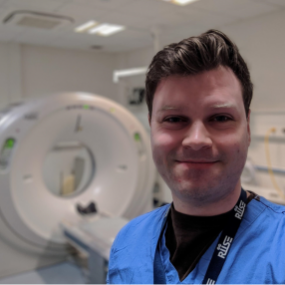Shining The Light Onto Radiology Requests

Dr Derek Smith is a neuroradiologist in Edinburgh, with interests in neuro-oncology, head and neck imaging and neurotrauma. He is on the editorial board of Radiopaedia.org, one of the world’s largest medical imaging resources and teaching websites.
As is often said of critical care teams, radiologists are another group who can be considered in the small cohort of the last few “true generalists”. Depending on the size of your hospital your radiologist will be doing anything from checking line placement on a CXR, removing a disabling MCA clot in an acute stroke patient, assessing a post-transplant liver in the unit on ultrasound, reducing a paediatric bowel intussusception, be scrubbed in securing a TEVAR in a aneurysm, or a combination of the above…
…even before getting started on the coffee queue prior to presenting 30 cases at the regional oncology multi-disciplinary meeting.
A substantial component of radiology is the vetting and prioritising of imaging requests, and this is what often leads to contact and (what we’ll call here) “conversations” with the referring clinical teams. More than half of UK medical students don’t spend any time in radiology departments, and a survey of Foundation doctors rated providing appropriate requests in the top five of things they wish they could do better (Bell, 2019). This unfamiliarity and anxiety of interacting with radiologists can persist into senior training, as consultants, and for non-medical specialist practitioners.
Here are a few tips (liberally inspired by McCoubrie’s Rules of Radiology) to help you get your patient the right imaging, at the right time, without getting your medical training called into question down the phone from the dark of the reporting room…
- Ask a question: Requesting a scan “because the surgeons said so” won’t get you very far! Coming to your radiologist, who is an imaging expert, and asking for advice or an opinion will start things moving in the right direction. Although you will always get a full report, if you can focus the radiologist’s attention and interest in a particular question you will get the answer you need. It might also change the type or timing of scan you originally thought might get done.
- Be concise…: Most radiology units used to run on A5 request cards, with the primary point to encourage distilled clinical information (especially for those with big handwriting). Now online request systems or “order comms” have white space text fields, but please don’t feel like you have to fill them. These should populate the clinical history in reports automatically, and you don’t want your request to be longer than the report.
- …but be detailed: Patients in critical care are rarely simple, and often will have lengthy clinical courses, interventions and previous imaging. Including a useful timeline of events, operative details, and known abnormalities will save your radiologist time trawling through pages of notes online and give you and our patient a timely report concentrated on what you need to know.
- Radiology is Big Data: In the mid-2000s a CT head was only 30 pixelated images. Most of the CT heads I reported today were 800+ images with 0.5 mm reconstructions, brain and bone algorithms, with multiple priors to compare against. Trauma CTs can have over 15000 images to interpret, and this is even before reviewing in various planes and windowing. There is more to see, and more to miss. Give radiologists time to give you the correct answer, rather than a wrong quick one.
- Don’t double up: Check recent imaging and, if possible on your system, see if requests are already in process for the scan you are about to ask for. Your unit may also be part of a regional PACS (for example in Scotland we can access nearly every scan performed in the NHS since 2007), and imaging may have been performed in an external hospital, especially if your large specialist ITU takes referrals from a regional or national network. Not only can this save you time, it will prevent duplication of efforts, unnecessary transfers and stop key things getting missed.
- Hocus POCUS? – We don’t want to admit it, but POCUS practitioners are almost certainly better at lung ultrasound than most radiologists. However, don’t put all your chips on the probe! Many pathologies will be sonographically-occult, and why rely on a <1 cm footprint when you have access to a CT scanner?
- Get to know your radiologists: Although all radiologists go through general training, many have different specialist interests. All will be able to provide teams with safe reports, but knowing who to go to for particular issues can save time and repetition. Some can churn through CXRs or CTPAs all day, but won’t report intracranial angiograms. Some will be happy to stick a needle into anything under US or CT guidance, others might not know one end of a nephrostomy from the other. As many boards and trusts rely on teleradiology out-of-hours (and sometimes in-hours), keeping channels open, promoting relationships and trust with your on-site radiologists is key. Consider setting up critical care imaging MDMs, or attending existing relevant meetings.
- Get to know your radiographers: ITU transfers take time and manpower for the critical care team and the radiographic staff. The radiographers usually run the scanning rooms and will be juggling emergency department, inpatient and outpatient lists all on the same scanner. Agreeing a realistic time to allow transfer and scan time will make everything go smoothly.
- It’s all about the patient – this is directly lifted from Rule #100 and is true for everything we do in radiology and ITU.
References
- LTO Bell, O Dick, N Ali, D Little. Undergraduate radiology education: foundation doctors’ experiences and preferences. (2019) Clin Radiol. 74(6):480-486.
- Paul McCoubrie. The Rules of Radiology. (2021) Springer, New York, USA. ISBN: 9783030652289
